Study on Wear Resistance Evolution of Cold-Rolled Strip Flatness Meter Surface-Strengthened Layer
Abstract
:1. Introduction
2. Materials and Methods
2.1. Detection Roller Sample and Friction and Wear Testing Machine
2.2. Test Scheme Design
2.3. Evaluation Methods for Wear Resistance
3. Results
3.1. Friction Coefficient Result
3.2. Comparison of Wear Morphology
3.3. Wear Result
4. Discussion
5. Conclusions
Author Contributions
Funding
Data Availability Statement
Acknowledgments
Conflicts of Interest
References
- Hao, L.; Ji, X.; Zhang, G.; Zhao, W.; Sun, M.; Peng, Y. Carbide precipitation behavior and mechanical properties of micro-alloyed medium Mn steel. J. Mater. Sci. Technol. 2020, 47, 122–130. [Google Scholar] [CrossRef]
- Klinkenberg, C.; Kintscher, B.; Hoen, K.; Reifferscheid, M. More than 25 Years of Experience in Thin Slab Casting and Rolling Current State of the Art and Future Developments. Steel Res. Int. 2017, 88, 1700272. [Google Scholar] [CrossRef]
- Qin, F.; Li, Y.; Qi, H.; Ju, L. Advances in Compact Manufacturing for Shape and Performance Controllability of Large-scale Components—A Review. Chin. J. Mech. Eng. 2017, 30, 7–21. [Google Scholar] [CrossRef]
- You, X.; Wang, C.; Huang, J.; Gao, X.; Zhang, Z.; Wang, M.; Huang, Y.; Zhang, C.; Jiang, Y.; Wang, J.; et al. Towards 6G wireless communication networks: Vision, enabling technologies, and new paradigm shifts. China Inf. Sci. 2021, 64, 110301. [Google Scholar] [CrossRef]
- Lian, J.; Liu, H. Shape and Thickness Control, 1st ed.; Weapon Industry Press: Beijing, China, 1995. [Google Scholar]
- Wang, G. Flatness Control and Flatness Theory, 1st ed.; Metallurgical Industry Press: Beijing, China, 1986. [Google Scholar]
- Qu, H.; Gu, T.; Fang, B. Research on development of surface-roughness variation and control technology of the automotive plates and rolls. Baosteel Tech. Res. 2019, 13, 8–19. [Google Scholar]
- Wang, D.; Liu, H.; Liu, J. Research and Development Trend of Shape Control for Cold Rolling Strip. Chin. J. Mech. Eng. 2017, 30, 1248–1261. [Google Scholar] [CrossRef]
- Yu, B.; Yang, L.; Liu, H.; Peng, Y.; You, L. Development and industrial application of cold-rolled strip steel contact shape meter. Chin. J. Sci. Instrum. 2010, 31, 904–911. [Google Scholar] [CrossRef]
- Liu, H.; Liu, J.; Yu, B.; Yang, L.; Zhang, Y. Whole roll wireless shape meter and intelligent shape control system for strip cold rolling mill. Chin. J. Mech. Eng. 2017, 53, 87–93. [Google Scholar] [CrossRef]
- Yu, H.; Liu, H.; Xu, Y.; Wang, D. Interpretation of the Chinese standard of cold-rolled strip flatness measurement and control system. J. Iron Steel Res. Int. 2019, 54, 52–57. [Google Scholar] [CrossRef]
- Yu, B.; Yang, L.; Sun, J. Research status of cold-rolled strip flatness detection roller. J. Iron Steel Res. Int. 2011, 28, 44–46. [Google Scholar] [CrossRef]
- Wang, P.; Zhang, D.; Liu, J.; Wang, J.; Yu, X. Research and Application of Calculation Model of Cold-rolled Plate Shape Measurement. Chin. J. Mech. Eng. 2011, 47, 58–65. [Google Scholar] [CrossRef]
- Yu, H.; Zhang, T.; Zhang, S.; Wang, D.; Liu, H. Quick Recognition and Elimination of an Additional Signal Caused by Deflection of an Integral Roller Flatness Meter: Instrumentation, Control and System Engineering. ISIJ Int. 2021, 61, 2571–2579. [Google Scholar] [CrossRef]
- Mevec, D.G.; Raninger, P.; Prevedel, P.; Jászfi, V. A Posteriori Reconstruction of the Temperature Distribution in Surface Hardened Tempering Steel. Sci. Rep. 2020, 10, 7481. [Google Scholar] [CrossRef] [PubMed]
- Sun, S.; Liu, W.; Zhang, X.; Wan, M. Crankshaft HCF Research Based on the Simulation of Electromagnetic Induction Quenching Approach and a New Fatigue Damage Model. Metals 2022, 12, 1296. [Google Scholar] [CrossRef]
- Ebrahimi, M.; Wang, Q. Accumulative roll-bonding of aluminum alloys and composites: An overview of properties and performance. J. Mater. Res. Technol. 2022, 19, 4381–4403. [Google Scholar] [CrossRef]
- Wu, J.; Djavanroodi, F.; Gode, C.; Ebrahimi, M.; Attarilar, S. Microstructure evolution, texture development, and mechanical properties of hot-rolled 5052 aluminum alloy followed by annealing. Mater. Res. Express 2022, 9, 056516. [Google Scholar] [CrossRef]
- Xu, H.; He, T.; Zhong, N.; Zhao, B.; Liu, Z. Transient thermomechanical analysis of micro cylindrical asperity sliding contact of SnSbCu alloy. Tribol. Int. 2022, 167, 107362. [Google Scholar] [CrossRef]
- Servin-Casta, E.R.; Garcia-Lara, A.M.; Mercado-Solís, R.D.; Vega-Lebrun, C.A. Development of Mathematical Model for Control Wear in Backup Roll for Hot Strip Mill. J. Iron Steel Res. Int. 2014, 21, 46–51. [Google Scholar] [CrossRef]
- Li, W. Simulation-based multi-objective optimization for roll shifting strategy in hot strip mill. J. Cent. South Univ. 2013, 20, 1226–1234. [Google Scholar] [CrossRef]
- Jia, S.; Li, W.; Liu, X.; Du, B. Multi-Objective Load Distribution Optimization for Hot Strip Mills. J. Iron Steel Res. Int. 2013, 20, 27–32. [Google Scholar] [CrossRef]
- Li, H.; Jiang, Z.; Tieu, A.K.; Wei, D. Experimental study on wear and friction of work roll material with 4% Cr and added Ti in cold rolling. Wear 2011, 271, 2500–2511. [Google Scholar] [CrossRef]
- Tieu, A.K.; Zhu, Q.; Zhu, H.; Lu, C. An investigation into the tribological behaviour of a work roll material at high temperature. Wear 2011, 273, 43–48. [Google Scholar] [CrossRef]
- Ueno, M.; Fujita, N.; Kimura, Y.; Nakata, N. Evaluation of coating and wear characteristics of roll surface coated with TiC by electrical discharge coating. J. Mater. Process Technol. 2016, 236, 9–15. [Google Scholar] [CrossRef]
- Xu, B.; Zhu, S. The Theory and Technology of Surface Engineering, 2nd ed.; Beijing National Defense Industry Press: Beijing, China, 2010. [Google Scholar]
- Azushima, A.; Yoneyama, S.; Utsunomiya, H. Coefficient of friction at interface of lubricated upsetting process. Wear 2012, 286, 3–7. [Google Scholar] [CrossRef]
- Meng, Y.; Xu, J.; Jin, Z.; Prakash, B.; Hu, Y. A review of recent advances in tribology. Friction 2020, 8, 221–300. [Google Scholar] [CrossRef]
- Liu, Z. Principles of Tribology, 1st ed.; Higher Education Press: Beijing, China, 2009. [Google Scholar]
- Graves, A.; Norgren, S.; Wan, W.; Singh, S.; Kritikos, M.; Xiao, C.; Crawforth, P.; Jackson, M. On the mechanism of crater wear in a high strength metastable β titanium alloy. Wear 2021, 484, 203998. [Google Scholar] [CrossRef]
- Goel, N.; Fong, T.M.; Shingledecker, J.P.; Russell, A.; Keller, M.W.; Shirazi, S.A.; Otanicar, T. Effect of temperature on abrasion erosion in particle based concentrating solar powerplants. Sol. Energy 2021, 224, 1127–1135. [Google Scholar] [CrossRef]
- Xi, L.; Guo, S.; Ding, K.; Prashanth, K.G.; Sarac, B.; Eckert, J. Effect of nanoparticles on morphology and size of primary silicon and property of selective laser melted Al-high Si content alloys. Vacuum 2021, 191, 110405. [Google Scholar] [CrossRef]
- Xu, C.; Li, P. Stress-free manufacturing technology. Chin. J. Mech. Eng. 2020, 56, 113–132. [Google Scholar]
- Lazzarotto, L.; Dubar, L.; Ravassard, P.; Dubois, A.; Oudin, J. Identification of Coulomb’s friction coefficient in real contact conditions applied to a wire drawing process. Wear 1997, 211, 54–63. [Google Scholar] [CrossRef]
- Nikolai, L.S.; Andrey, V.F.; Sergei, Y.T.; Tarasov, I.D.; Evgeny, V.S.; Aleksandr, S.G. Acoustic emission characterization of sliding wear under condition of direct and inverse transformations in low temperature degradation aged Y-TZP and Y-TZP-Al_2O_3. Friction 2018, 6, 323–340. [Google Scholar]
- Ji, Z.; Zhang, L.; Xie, G.; Xu, W.; Guo, D.; Luo, J.; Prakash, B. Mechanical and tribological properties of nanocomposites incorporated with two-dimensional materials. Friction 2020, 8, 813–846. [Google Scholar] [CrossRef]
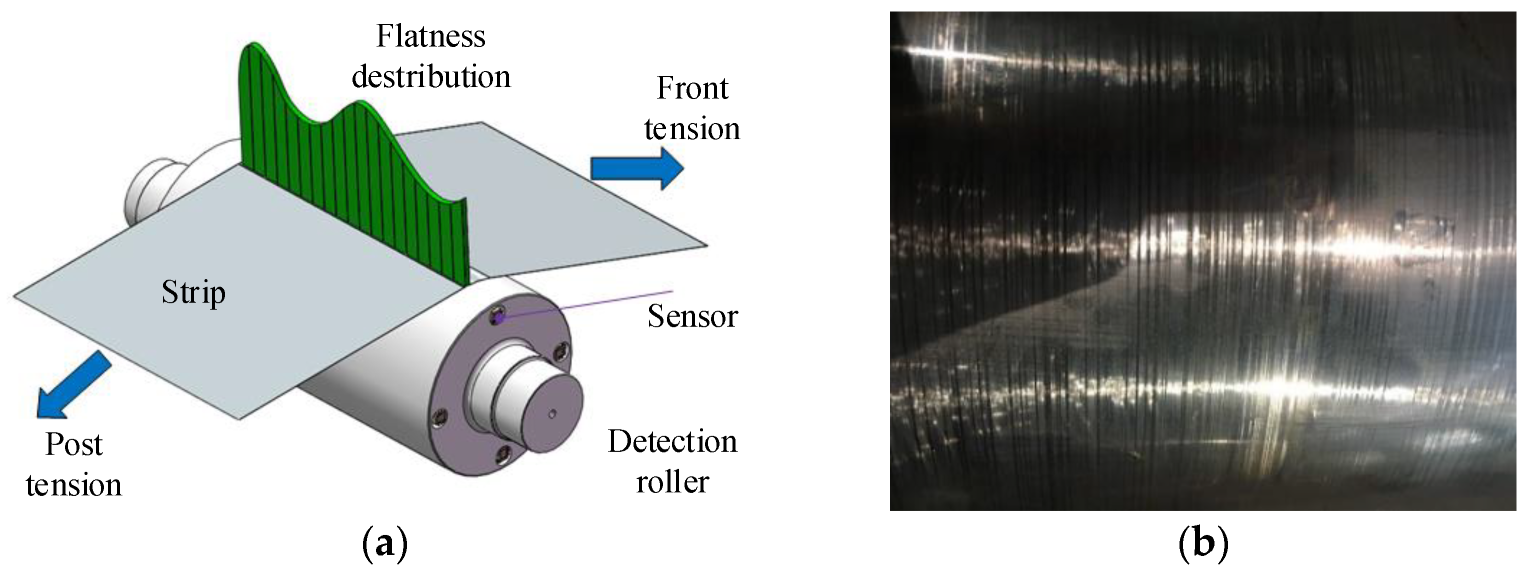

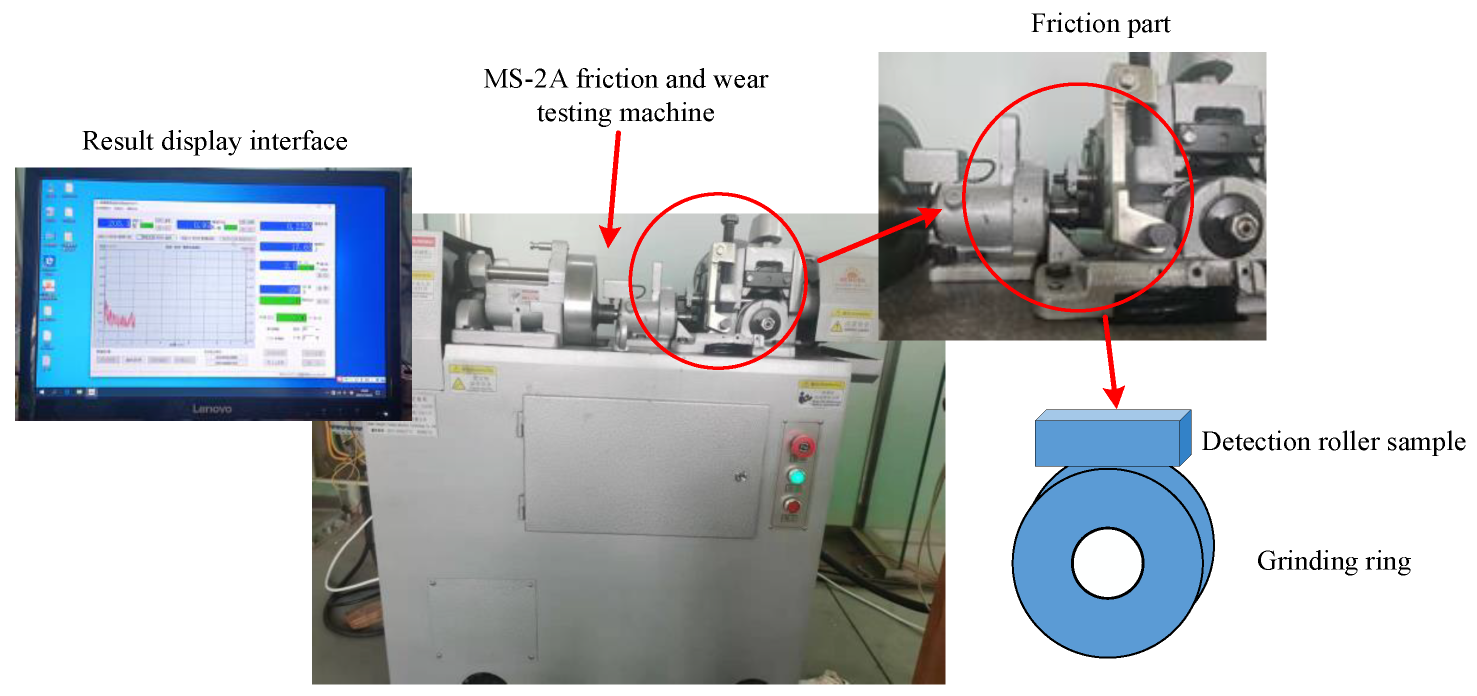
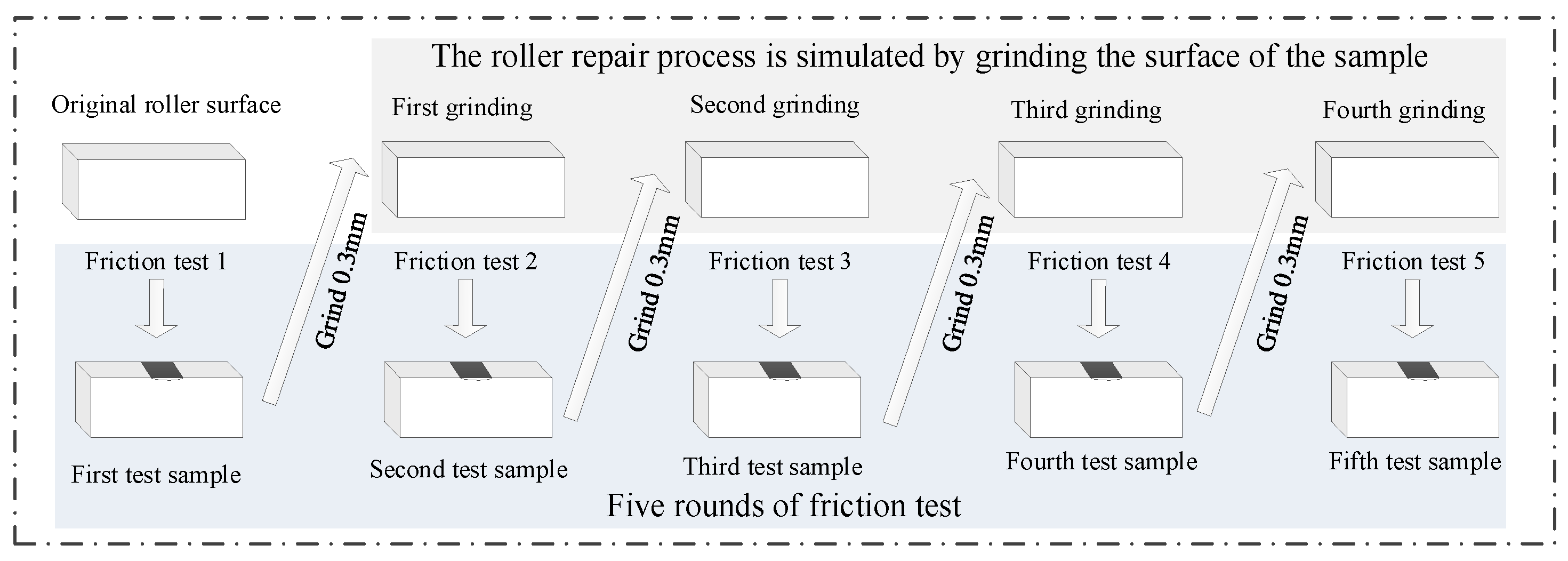

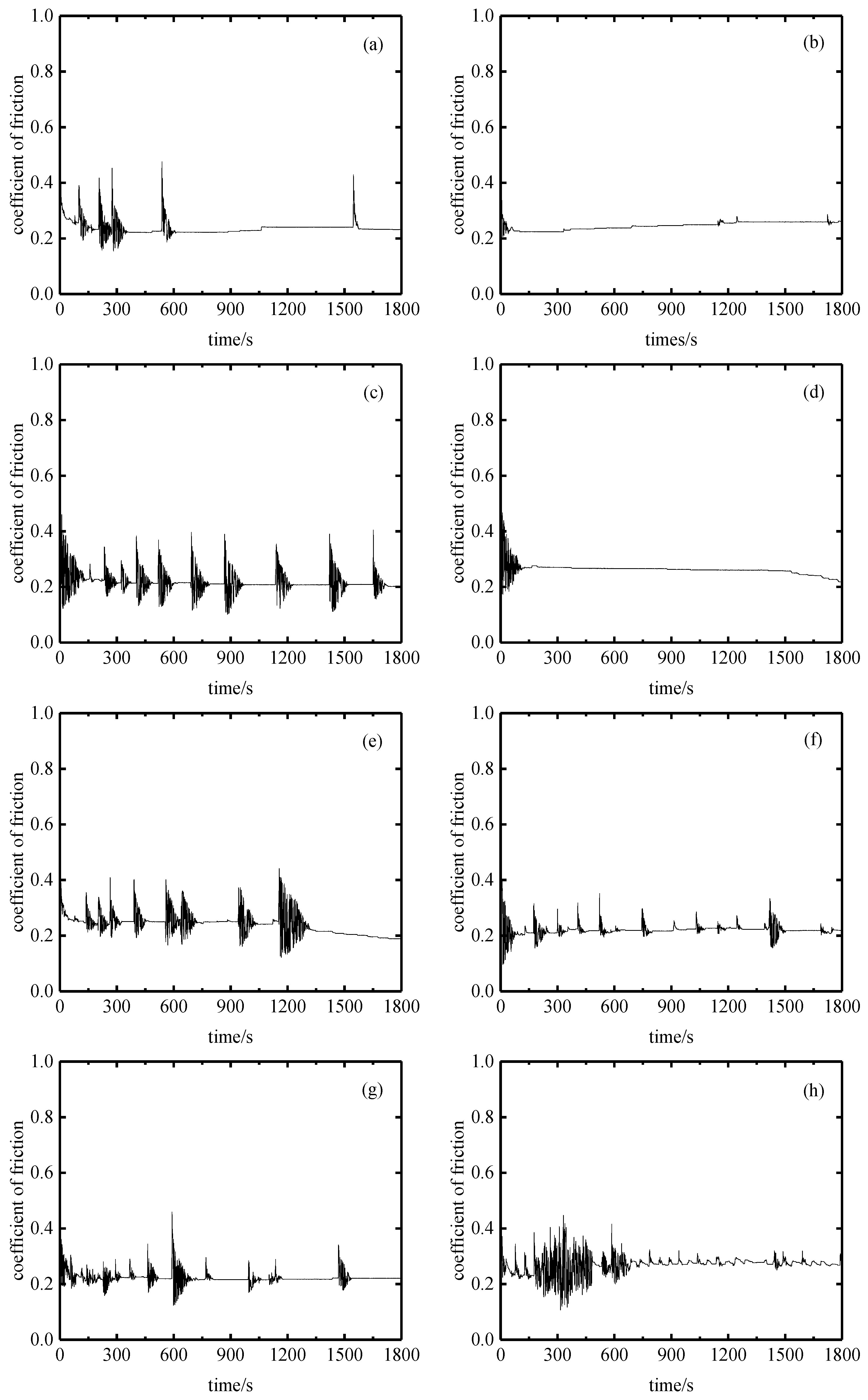

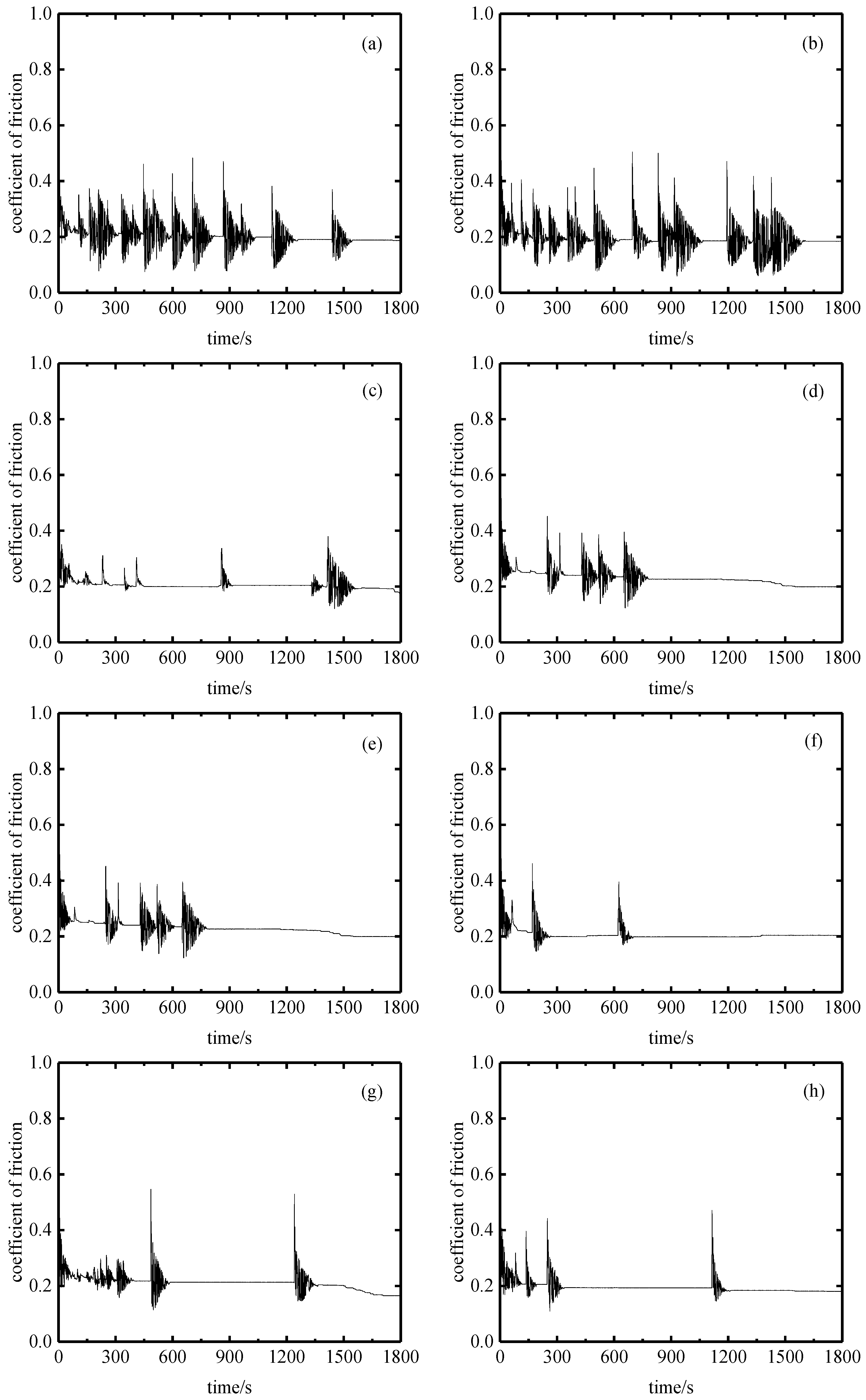
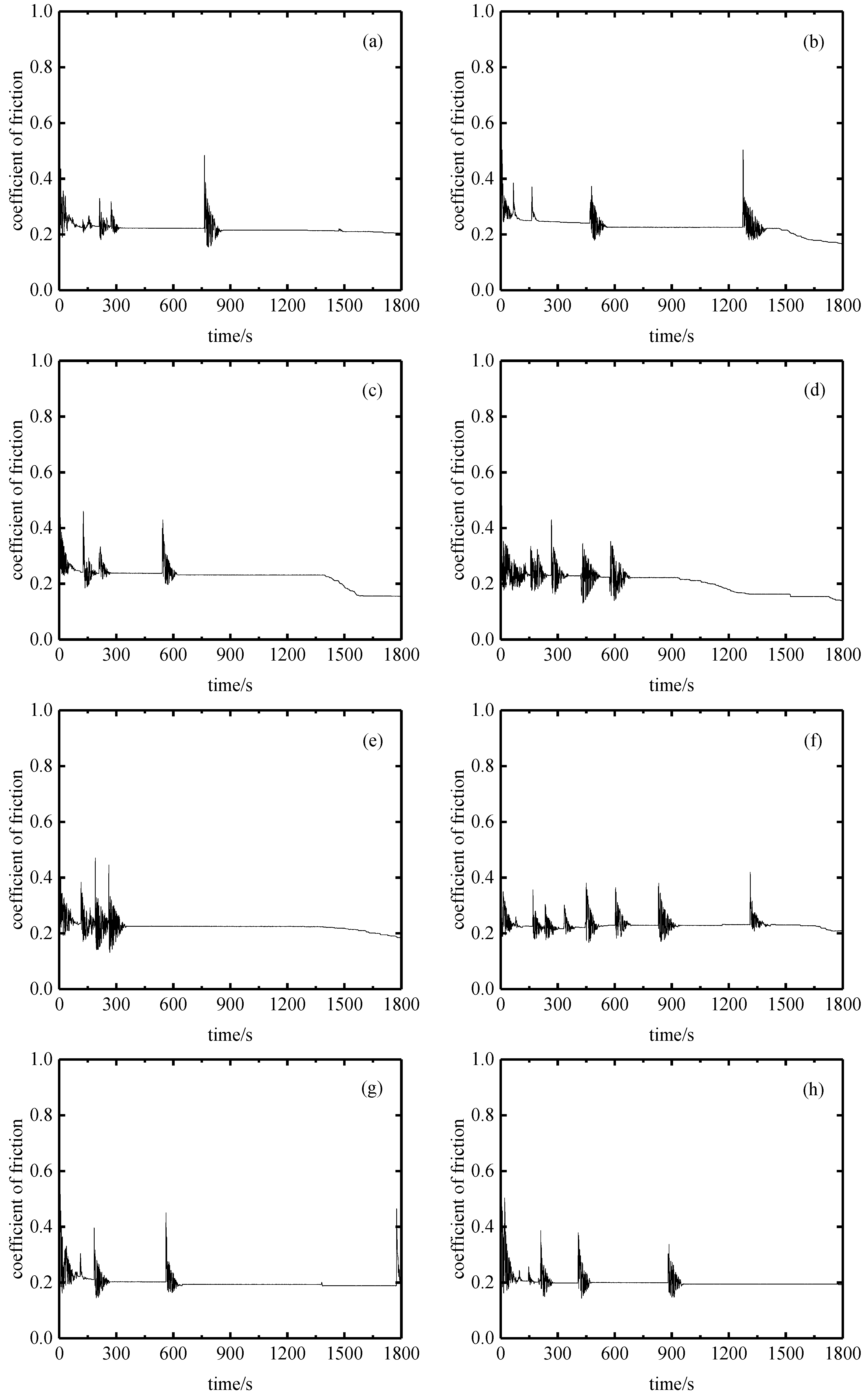



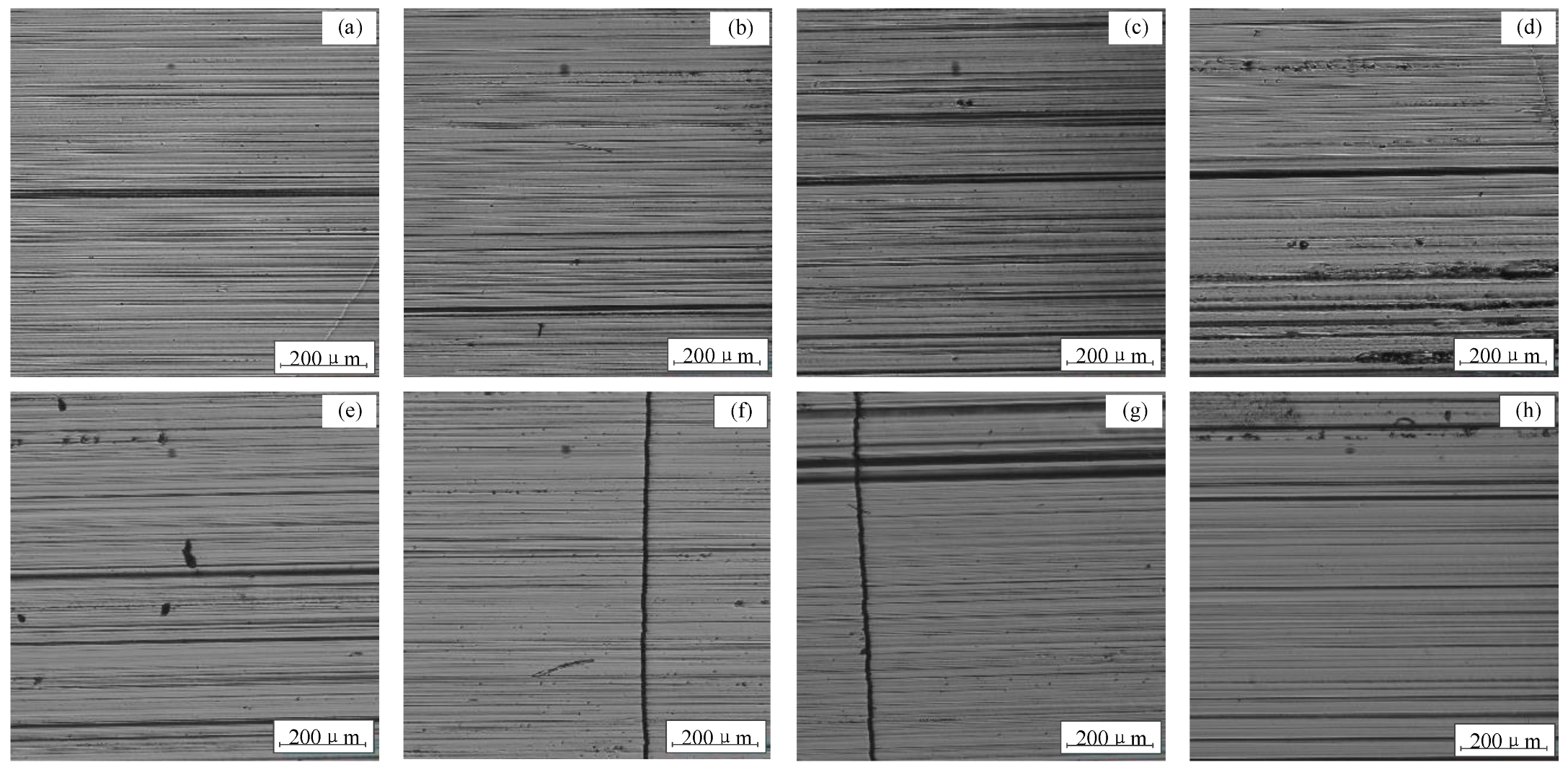



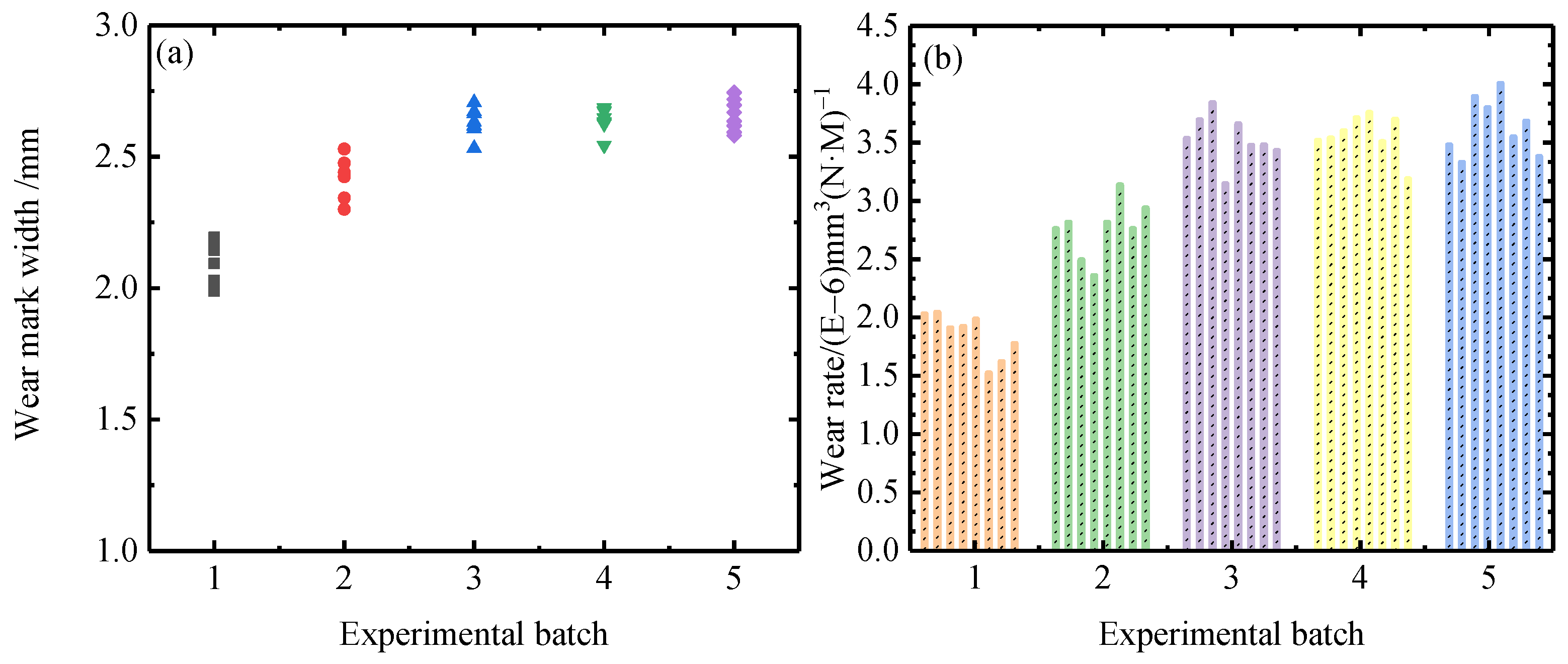

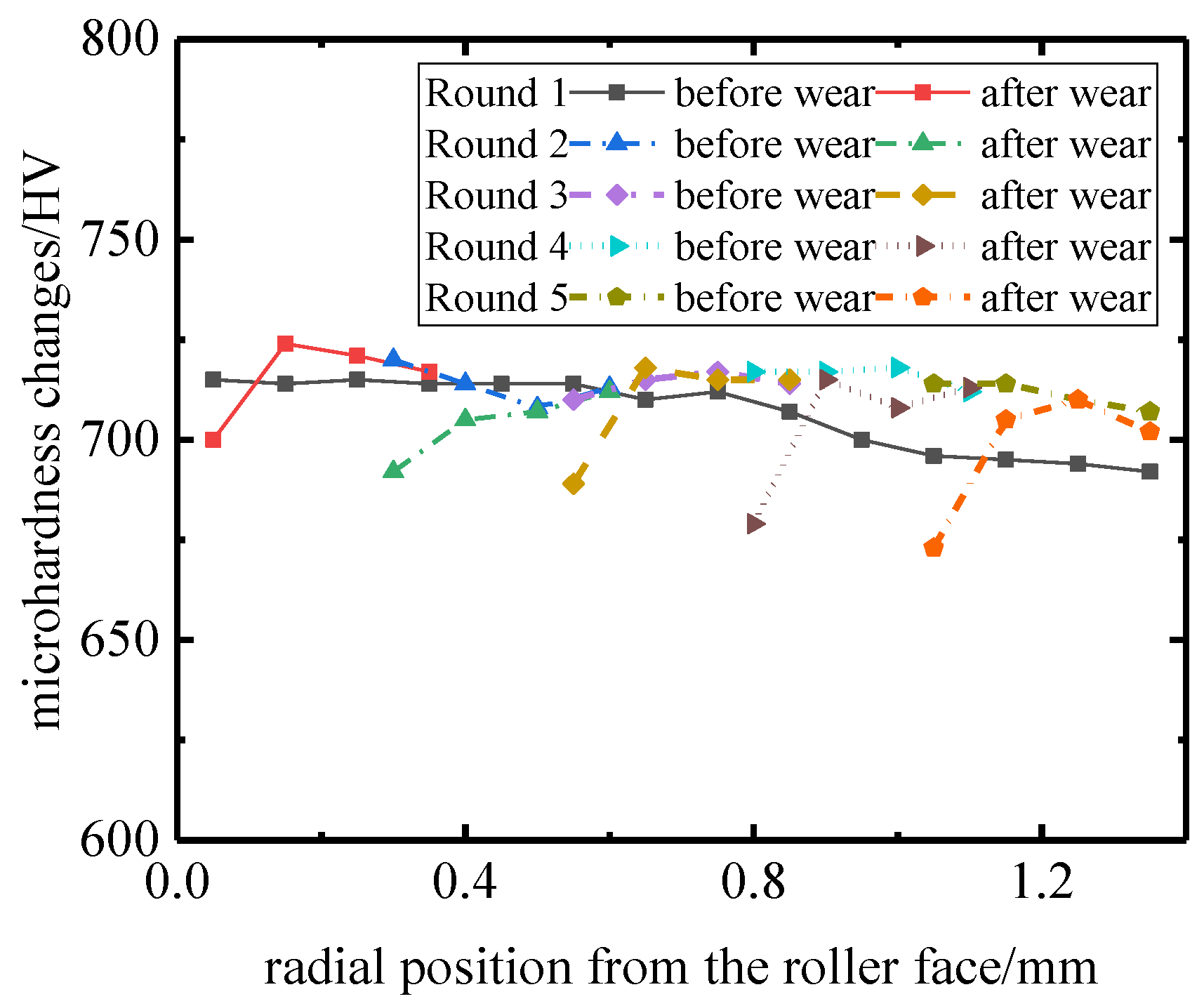
| Element | C | Si | Mn | P/S | Cr | Mo | V |
|---|---|---|---|---|---|---|---|
| Content | 0.85~0.95 | 0.25~0.45 | 0.20~0.35 | ≤0.30 | 1.70~2.10 | 0.20~0.40 | 0.10~0.20 |
| Load/N | Speed /r·min−1 | Time/min | Grinding Ring Material | Grinding Ring Hardness | Grinding Ring Diameter/mm | Temperature/°C | Lubrication |
|---|---|---|---|---|---|---|---|
| 200 | 200 | 30 | Cr12MoV | 55HRC | 40 | Room temperature | 0.04 mL- Glycerin |
Disclaimer/Publisher’s Note: The statements, opinions and data contained in all publications are solely those of the individual author(s) and contributor(s) and not of MDPI and/or the editor(s). MDPI and/or the editor(s) disclaim responsibility for any injury to people or property resulting from any ideas, methods, instructions or products referred to in the content. |
© 2023 by the authors. Licensee MDPI, Basel, Switzerland. This article is an open access article distributed under the terms and conditions of the Creative Commons Attribution (CC BY) license (https://creativecommons.org/licenses/by/4.0/).
Share and Cite
Zhang, S.; Liao, S.; Li, S.; Zhang, T.; Yu, H.; Liu, H. Study on Wear Resistance Evolution of Cold-Rolled Strip Flatness Meter Surface-Strengthened Layer. Metals 2023, 13, 914. https://doi.org/10.3390/met13050914
Zhang S, Liao S, Li S, Zhang T, Yu H, Liu H. Study on Wear Resistance Evolution of Cold-Rolled Strip Flatness Meter Surface-Strengthened Layer. Metals. 2023; 13(5):914. https://doi.org/10.3390/met13050914
Chicago/Turabian StyleZhang, Shuai, Shuang Liao, Shan Li, Tongyuan Zhang, Huaxin Yu, and Hongmin Liu. 2023. "Study on Wear Resistance Evolution of Cold-Rolled Strip Flatness Meter Surface-Strengthened Layer" Metals 13, no. 5: 914. https://doi.org/10.3390/met13050914
APA StyleZhang, S., Liao, S., Li, S., Zhang, T., Yu, H., & Liu, H. (2023). Study on Wear Resistance Evolution of Cold-Rolled Strip Flatness Meter Surface-Strengthened Layer. Metals, 13(5), 914. https://doi.org/10.3390/met13050914






